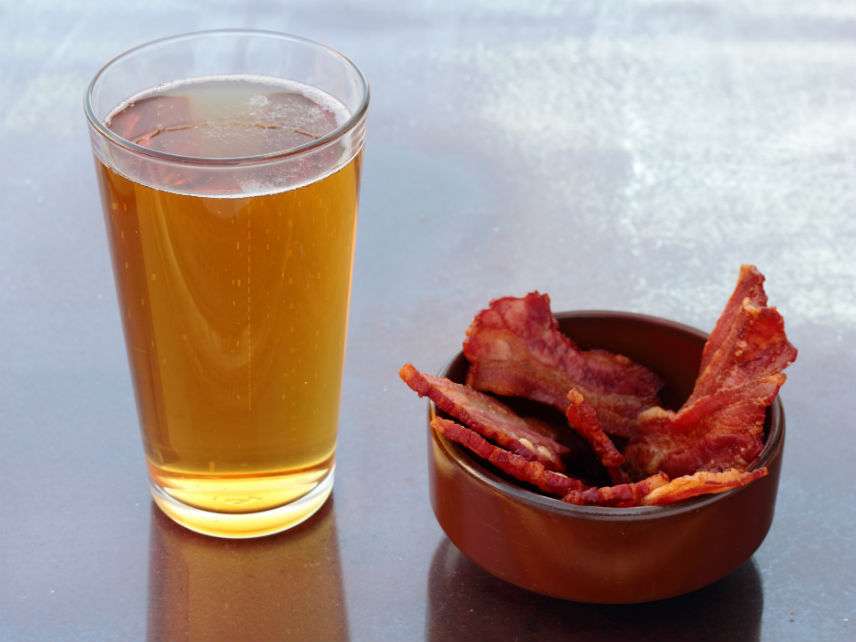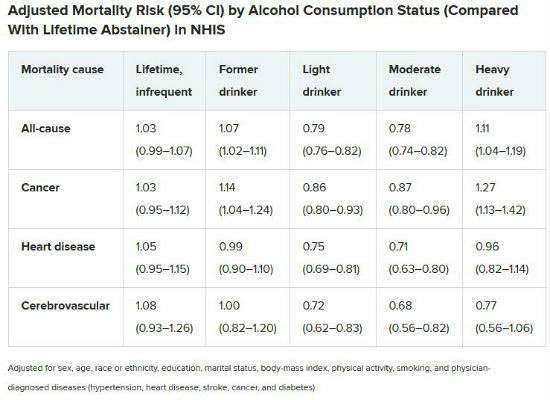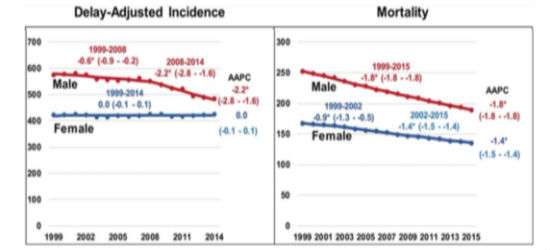New Cancer Report Tries To Scare You Out of Eating Sausage and Bacon
Nevertheless, U.S. cancer rates are stable for women and declining for men.

"No amount of alcohol, sausage or bacon is safe," declares the Daily Mirror. The article is about the latest cancer prevention dietary guidelines from the World Cancer Research Fund (WCRF), which isn't actually as alarmist as that sentence sounds. The WCRF report estimates that eating the equivalent of two strips of bacon a day would boost your risk of colorectal cancer by 16 percent. Translation: Eating about 38 pounds of bacon a year—or the equivalent weight in sausages and hot dogs—will raise your lifetime risk of colorectal cancer from about 4.5 percent to 5.2 percent for men and from 4.15 percent to 4.8 percent for women.
As far as alcohol goes, the WCRF estimates that drinking 20 grams of ethanol a day (a standard drink contains 14 grams) will increase your risk of colorectal cancer by 7 percent. Three drinks a day raises your risk of liver cancer by 6 percent. A mere 10 grams of alcohol per day increases your risk of esophageal cancer by 41 percent. And for women, drinking as little as 10 grams per day boosts their risk of breast cancer by 9 percent. So these relatively modest rates of tippling (absent other confounding factors) would increase your absolute lifetime risk colorectal cancer from 4.5 to 4.8 percent; liver cancer from 1 to 1.06 percent; esophageal cancer from 0.75 to 1 percent (if you're a man) or from 0.22 to 0.3 percent (if you're a woman); and breast cancer from 12.4 to 13.5 percent.
Meanwhile, a huge 2017 meta-analysis in the Journal of the American College of Cardiology finds significant health benefits from light to moderate drinking. For the purposes of the study, light drinking is defined as fewer than 3 drinks a week, moderate drinking is more than 3 and less than 14 drinks a week for men and less than 7 for women, and heavy drinking is more than 14 a week for men and more than 7 for women. To some extent, there is a trade-off between reduced cardiovascular risks and higher cancer risks. Some drinking may even help people avoid some cancers: Medscape reports of the Journal of the American College of Cardiology study that "light and moderate alcohol intake predicted reduced all-cause, cardiovascular, and cancer mortalities in both men and women."

For comparison, consider that the risk that persistent cigarette smokers will develop lung during their lifetimes is 1,100 percent greater than the risk that a nonsmoker will.
The WCRF also reports that being tall is a cancer risk. For every extra 2 and half inches over 5 feet and 2 inches in height, the WCRF finds that the risk of prostate cancer increases by 7 percent. My adult height is 6 feet 5 inches, suggesting that my risk of prostate cancer is up 40 percent. This boosts my lifetime risk for prostate cancer from 11 to a bit over 15 percent.
To mitigate these risks, the WCRF recommends: "Eat little, if any, processed meats" and "For cancer prevention, it's best not to drink alcohol." Noting the "people cannot necessarily influence" how tall they grow, the WCRF makes "no global recommendations" regarding cancer risks associated with stature.
As it happens, the National Institutes of Health has just issued its Annual Report to the Nation on the Status of Cancer, which reports that the incidence of cancer among men has been declining by 2.2 percent per year since 1999. The cancer incidence rate for women has remained flat over that period. Cancer mortality trends are declining for both men and women, due largely to earlier diagnoses and more effective treatments. Cancer mortality for men fell at a rate of 1.8 percent per year; for women, it fell 1.4 percent annually. The five-year cancer survival rate in 1953 was 35 percent, increasing to 49 percent in 1977 and now around 68 percent. Since 1999, colorectal and esophageal cancer rates have been falling while those for liver and breast cancer have been rising a bit. Over the course of their lives, about 1 in 3 Americans will develop cancer and about 1 in 5 will die of the disease.

The declining overall cancer incidence rates occurred at the same time that per capita U.S. consumption of alcohol was increasing slightly from 2.16 gallons of ethanol in the mid-1990s to 2.33 gallons now. That amounts to slightly less than two daily drinks per person. The WCRF reports that global average annual consumption of alcohol is about 1.7 gallons per person—but just under half of the world's adult population has never consumed alcohol. In addition, pork consumption in the U.S. has remained steady at about 50 pounds per person annually for the past couple of decades. And Americans annually eat an average of 18 pounds of bacon and 70 hot dogs—about 9 pounds—per person.
A study in December concluded that about 42 percent of cancers are attributable to modifiable risk factors. The researchers estimated that cigarette smoking accounts for 19 percent of cancer cases, excess body weight for 7.8 percent, alcohol for 5.6 percent, UV radiation for 4.7 percent, physical inactivity for 2.9 percent, low consumption of fruits and vegetables for 1.9 percent, and HPV infection for 1.8 percent. The researchers attributed just 0.9 and 0.5 percent of cancers to the consumption of processed and red meats respectively.
So if lifestyle and environmental factors are responsible for only about 40 percent of cancers, what causes most cases of the disease? Bad luck, according to a recent study by biostatistician Cristian Tomassetti and oncologist Bert Vogelstein, both of Johns Hopkins University. The research was prompted by the fact that cancer often strikes people who follow all the rules of healthy living—no smoking, a healthy diet, a healthy weight, little or no exposure to known carcinogens—and who have no family history of the disease.
Parsing data on the risk of 17 cancer types in 69 countries, the researchers report "evidence that random, unpredictable DNA copying 'mistakes' account for nearly two-thirds of the mutations that cause cancer." Basically, cancer most often arises in tissues where cells are constantly being replaced, such as colon and skin. The unavoidable proliferation of random genetic copying errors increases the chances that a cell will mutate in ways that turn it cancerous. "These cancers will occur no matter how perfect the environment," says Vogelstein.
Given their relatively low cancer risks, I will continue to enjoy bacon and cocktails. More cautious folks are free to choose otherwise.
The upshot is the longer you live, the more likely it is that intemperate lifestyle choices or sheer bad luck will catch up to you and give you cancer. As Massachusetts Institute of Technology oncologist Robert Weinberg has observed, "If you live long enough, you will get cancer."

Show Comments (58)